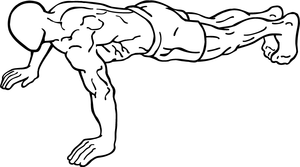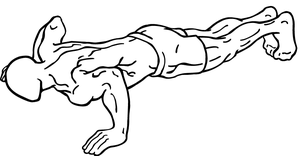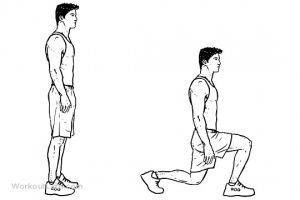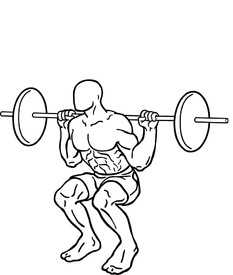Closed Chain Exercise: Difference between revisions
mNo edit summary |
mNo edit summary |
||
| Line 60: | Line 60: | ||
=== Closed Chain Upper Body Kinetic Exercises === | === Closed Chain Upper Body Kinetic Exercises === | ||
Examples include push-ups and derivatives, pull-ups or chin-ups, and dips. These concentrate on a co-contraction of the triceps brachii, [[biceps brachii]], [[Deltoid|deltoids]], [[pectoralis major]] and minor, and lower back for stabilization in various ratios depending upon the angle and leverage.<br> | Examples include push-ups and derivatives, pull-ups or chin-ups, and dips. These concentrate on a co-contraction of the [[Triceps brachii|triceps]] brachii, [[biceps brachii]], [[Deltoid|deltoids]], [[pectoralis major]] and minor, and lower back for stabilization in various ratios depending upon the angle and leverage.<br> | ||
[[File: | [[File:Pushup1.png|thumb]] | ||
[[File:Pushup2.png|thumb|Pushup]] | |||
{{#ev:youtube|jjCt5RYBBAI}}<ref>Bob&Brad.5 Closed Chain Exercises for Your Shoulder (Strengthen & Stabilize) Available from: https://www.youtube.com/watch?v=jjCt5RYBBAI</ref> | {{#ev:youtube|jjCt5RYBBAI}}<ref>Bob&Brad.5 Closed Chain Exercises for Your Shoulder (Strengthen & Stabilize) Available from: https://www.youtube.com/watch?v=jjCt5RYBBAI</ref> | ||
| Line 73: | Line 73: | ||
== Multiple Joint Exercises == | == Multiple Joint Exercises == | ||
Closed kinetic chain exercise corresponds closely with the exercises classified as Multiple- joint exercises. During this exercise, movement occurs at multiple levels involving muscular co-contraction. The primary benefit of this exercise is the ability to exercise numerous segments and muscle groups simultaneously. <ref name=":0" /> | Closed kinetic chain( CKC) exercise corresponds closely with the exercises classified as Multiple- joint exercises. During this exercise, movement occurs at multiple levels involving muscular co-contraction. The primary benefit of this exercise is the ability to exercise numerous segments and muscle groups simultaneously. <ref name=":0" /> | ||
== Research Resources == | == Research Resources == | ||
=== CKCE on Dynamic Balance ability of Normal Healthy Adult === | === CKCE on Dynamic Balance ability of Normal Healthy Adult === | ||
Several systems of the human body like the nervous, musculature, and skeletal interact with each other to maintain balance. Various exercises like open and closed kinetic chain exercises, aerobic exercises, Tai Chi exercises are used to improve balance. | Several systems of the human body like the nervous, musculature, and skeletal interact with each other to maintain balance. Various exercises like open and closed [[Kinetic Chain|kinetic chain]](KC) exercises, [[Aerobic Exercise|aerobic exercises]], Tai Chi exercises are used to improve [[Balance|balance.]] | ||
Thirty-three healthy adults who have no exercise habit participated in the study to investigate whether open and closed kinetic chain exercises improve dynamic balance ability. CKC exercises involved hip, knee, and ankle muscles, while OKC exercises were isolated to the knee extensors.T he final result of the study shows that the KC group, on average, started off with poorer balance than the OKC group, but finished with better balance than the OKC group which shows CKC exercises are effective.<ref name=":1" /> | Thirty-three healthy adults who have no exercise habit participated in the study to investigate whether open and closed kinetic chain exercises improve dynamic balance ability. CKC exercises involved [[Hip Anatomy|hip]], [[knee]], and [[Ankle and Foot|ankle]] [[Muscle|muscles]], while [[Open Chain Exercise|open Kinetic chain]] (OKC ) exercises were isolated to the knee extensors.T he final result of the study shows that the KC group, on average, started off with poorer balance than the OKC group, but finished with better balance than the OKC group which shows CKC exercises are effective.<ref name=":1" /> | ||
=== CKC exercises and its effect in jumping performance === | === CKC exercises and its effect in jumping performance === | ||
Revision as of 09:37, 7 October 2020
Original Editors - Vanderpooten Willem Rewan Elsayed Elkanafany Top Contributors - Johnathan Fahrner, Kakshya Rupakheti, Garima Gedamkar, Admin, Vanderpooten Willem, Lucinda hampton, Evan Thomas, Rewan Elsayed Elkanafany, Alberto Bertaggia, WikiSysop, Kim Jackson, Scott Cornish, Claire Knott, Wanda van Niekerk, Ahmed M Diab and Tarina van der Stockt
Introduction[edit | edit source]
Closed Kinetic Chain (CKC) exercises or closed chain exercises are exercises or movements where the distal aspect of the extremity is fixed to an object that is stationary.
With the distal part fixed, movement at any one joint in the kinetic chain requires motion as well at the other joints in the kinetic chain, therefore, both proximal and distal parts receive resistance training at the same time.[1]
CKC exercises have gained popularity over Open Kinetic Chain (OKC) exercises because many therapists believe that CKC exercises are more reliable and functional.[2] Uçar et al. affirmed that for rehabilitation post ACL reconstruction, CKC exercises were more effective than OKC exercises at regaining mobility and enabling a quicker return to daily and sporting activities.[3]
Superior eccentric contraction and co-contraction of muscles are produced by closed kinetic chain exercises. Along with that, the shear forces are reduced while adding comprehensive forces to the joints which enhances joint stability.[4]
Characteristics of CKC exercises and the difference between OKC exercises:[5]
| Characteristic |
Closed kinetic chain exercises |
Open kinetic chain exercises |
| Stress pattern |
Linear |
Rotary |
| Number of joint axes |
Multiple |
One primary |
| Nature of joint segments |
Both segments move simultaneously |
One stationary, other mobile |
| Number of moving joints |
Multiple joint movements |
Isolated joint motion |
| Planes of movement |
Multiple (triplanar) |
One (single) |
| Muscular involvement |
Significant co-contraction |
Isolation of muscle group, minimal muscular co-contraction |
| Movement pattern |
Significant functionally oriented |
Often non-functional |
Biomechanical and Neurophysiological Factors[edit | edit source]
Biomechanical:
- CKC techniques emphasise the sequential movement and placement of functionally related joints and therefore require coordinated and sequential muscle activation patterns to control proper joint movement.[6]
Neurophysiological:
- Closed kinetic chain exercises stimulate the proprioceptive system by proprioceptive feedback to initiate and control muscle activation patterns.[6]
Exercises[edit | edit source]
Closed Chain Upper Body Kinetic Exercises[edit | edit source]
Examples include push-ups and derivatives, pull-ups or chin-ups, and dips. These concentrate on a co-contraction of the triceps brachii, biceps brachii, deltoids, pectoralis major and minor, and lower back for stabilization in various ratios depending upon the angle and leverage.
Closed Chain Lower Body Kinetic Exercises[edit | edit source]
Examples include squats, deadlifts, lunges, power cleans, and leg presses. These concentrate on a co-contraction of the quadriceps, hamstrings, hip flexors, soleus and gastrocnemius muscles. The joints of movement include the knee, hip, and ankle.
Example of standing squat as a closed kinetic chain exercise. During this exercise, feet remain fixed to the ground, and resistance is manifested by the surface as a consequence of the individual's body weight or added weights in any form like dumbells.[8]
Multiple Joint Exercises[edit | edit source]
Closed kinetic chain( CKC) exercise corresponds closely with the exercises classified as Multiple- joint exercises. During this exercise, movement occurs at multiple levels involving muscular co-contraction. The primary benefit of this exercise is the ability to exercise numerous segments and muscle groups simultaneously. [8]
Research Resources[edit | edit source]
CKCE on Dynamic Balance ability of Normal Healthy Adult[edit | edit source]
Several systems of the human body like the nervous, musculature, and skeletal interact with each other to maintain balance. Various exercises like open and closed kinetic chain(KC) exercises, aerobic exercises, Tai Chi exercises are used to improve balance.
Thirty-three healthy adults who have no exercise habit participated in the study to investigate whether open and closed kinetic chain exercises improve dynamic balance ability. CKC exercises involved hip, knee, and ankle muscles, while open Kinetic chain (OKC ) exercises were isolated to the knee extensors.T he final result of the study shows that the KC group, on average, started off with poorer balance than the OKC group, but finished with better balance than the OKC group which shows CKC exercises are effective.[4]
CKC exercises and its effect in jumping performance[edit | edit source]
The research is done to find whether CKC exercise provides a superior means of optimum functional performance in healthy adults or injured individuals.
Twenty female physiotherapy students are the subject group in this study with no medical history. The result of the study showed a positive relation between closed kinetic chain exercises and jumping performance. The exercise improves vertical and long jumping performance.[9]
Clinical Bottom Line[edit | edit source]
Many factors should be considered when deciding whether to use open kinetic chain versus closed kinetic chain exercises. The patient's condition and stage of rehabilitation will aid in the judgement of exercise prescription.
References[edit | edit source]
- ↑ Kwon YJ, Park SJ, Jefferson J, Kim K. The Effect of Open and Closed Kinetic Chain Exercises on Dynamic Balance Ability of Normal Healthy Adults. J Phys Ther Sci. 2013 Jun;25(6):671–4.
- ↑ Bynum EB, Barrack RL, Alexander AH. Open versus closed chain kinetic exercises after anterior cruciate ligament reconstruction. A prospective randomized study. Am J Sports Med. 1995 Aug;23(4):401–6.
- ↑ Uçar M, Koca I, Eroglu M, Eroglu S, Sarp U, Arik HO, et al. Evaluation of Open and Closed Kinetic Chain Exercises in Rehabilitation Following Anterior Cruciate Ligament Reconstruction. J Phys Ther Sci. 2014 Dec;26(12):1875–8.
- ↑ 4.0 4.1 Kwon YJ, Park SJ, Jefferson J, Kim K. The effect of open and closed kinetic chain exercises on dynamic balance ability of normal healthy adults. Journal of physical therapy science. 2013 Jun 25;25(6):671-4.
- ↑ Ellenbecker TS, Davies GJ. Closed kinetic chain exercises. A comprehensive guide to multiple-joint exercises. J Chiropr Med 2002;1(4):200.
- ↑ 6.0 6.1 Akuthota V, Herring SA. Nerve and vascular injuries in sports medicine. Springer, 2009.
- ↑ Bob&Brad.5 Closed Chain Exercises for Your Shoulder (Strengthen & Stabilize) Available from: https://www.youtube.com/watch?v=jjCt5RYBBAI
- ↑ 8.0 8.1 Ellenbecker TS, Davies GJ. Closed kinetic chain exercise: a comprehensive guide to multiple joint exercises. Human Kinetics; 2001. Available From: http://bit.ly/1NunaL7
- ↑ Blackburn JR, Morrissey MC. The relationship between open and closed kinetic chain strength of the lower limb and jumping performance. Journal of Orthopaedic & Sports Physical Therapy. 1998 Jun;27(6):430-5.










